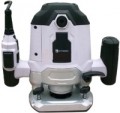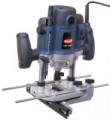Power
The total power of the router, more precisely, the engine installed in it. The
higher this indicator, the more productive the device is, the better it copes with complex work, the more force on the cutter (torque) it provides during operation, and the greater the spindle speed can be (although a powerful tool is not necessarily high-speed). On the other hand, high power significantly affects the dimensions, weight and price of the tool, plus power consumption and network load increase accordingly. In addition, high torque in some cases (for example, with delicate processing) is frankly undesirable. Therefore, a tool should be chosen according to this parameter, taking into account the real needs and the specifics of the planned work.
There are three main categories of milling cutters in terms of power: light (up to 700 W), designed mainly for simple household work; medium (up to 1500 W), able to cope not only with domestic, but also with most professional tasks; and heavy (1500 W or more), used in cases where high power is critical. However, this gradation is true only for routers (see "Type"), other varieties have their own specifics: for example, lamellar models, in principle, do not need high power.
Functions
—
Soft start. The presence of a soft start engine in the design of the milling cutter. A feature of most modern electric motors is that when connected to the network directly, without control circuits, at the time of start-up, there is a sharp jump in current through the motor. This, on the one hand, creates voltage fluctuations in the mains (which can “knock out” fuses or become fatal for some devices operating nearby), on the other hand, it leads to a sharp jerk of the tool, due to which it can be released from hands (and this cause damage to surrounding objects and even injury). This function also limits the current at the moment of starting the motor. Due to this, the speed increases smoothly, without jerking the tool, and the power grid is not subjected to excessive overloads.
—
Adjustment of frequency of rotation. The presence of a speed controller in the design of the milling cutter. This function allows you to change the spindle speed, adjusting it to different types of work — for example, to effectively cut hard material, you may need a high speed, and with soft woods, you can work at low speeds. Tools with speed control will be useful especially for those who have to deal with a wide variety of materials. In this case, the range of such adjustment may be different.
—
Microlift. The presence in the design of the router of a system for fine-tuning
...the depth with an accuracy of 0.1 mm. The standard setting with the limit pin is very coarse, as the errors are quite large. The microlift is used where it is important to set the depth very accurately. It is implemented mainly by means of a threaded connection that limits the vertical downward movement, or is completely integrated into the vertical travel design, where unlocking is not needed to make the necessary adjustments.
— Backlight. The presence of a lighting system in the design of the router — in fact, an ordinary flashlight that facilitates work in dimly lit places. The need for backlighting may arise even in daylight or bright artificial lighting — the place of work is quite often in the shade (for example, from the head of the operator himself).
— Maintain momentum. The presence in the design of the milling cutter of a system that automatically adjusts the engine operation mode depending on the load on the working nozzle — in such a way that the rotational speed remains constant, does not fall under load and does not increase at idle. Thanks to this adjustment, a constant quality of processing is ensured, practically independent of the pressure on the nozzle, wear of the nozzle and the tool itself is reduced, as well as overall energy consumption.In box
Additional equipment included in the delivery of the router in addition to the device itself.
—
Fresa. Working nozzles — milling cutters — can be included in the delivery set of milling cutters, this eliminates the need to purchase such nozzles separately. On the other hand, before buying a tool with this feature, you should make sure that the complete cutters correspond to the features of the planned work — otherwise you may overpay for unnecessary nozzles. Usually, there are several cutters in the set.
—
Dust collector. A special container for collecting dust, sawdust and other debris generated during the operation of the router. Most often it is made in the form of a soft bag, and a special pipe is used to connect to the tool (a vacuum cleaner can also be connected through the same pipe). Note that the overwhelming majority of modern milling cutters are equipped with nozzles for dust collectors, but the bags in the kit are relatively rare. Usually, a dust bag can be purchased separately, but for some users it is preferable to immediately buy a tool with a bag.
—
Copy base. The copy base is the base (sole) of the router (see "Type"), specially designed to work with copy sleeves. The copy sleeve is a ring fixed on the tool body, into which the cutter is threaded. When working with such a sleeve, the operator rests the outer edge of the ring agai
...nst the template and moves the tool in such a way that the base is constantly pressed against the template. Thus, the distance between the cutter and the template remains unchanged, and the working nozzle repeats the shape of the template; this is indispensable for precise work, especially with lines of complex shape. Many routers allow you to install a copy sleeve on a regular sole, however, there are models in which you need to install a special copy base for this. Such a base has certain differences from the standard one, due to the specifics of the work — in particular, it usually does not have depth adjustment, because. the presence of an adjustment mechanism can adversely affect the accuracy of work.
— Protective limiter. The protective limiter is a small ring that covers the working nozzle. This ring, as the name suggests, provides additional protection for the operator from dust, chips and other debris generated during operation. In addition, it prevents foreign objects (primarily fingers) from getting under the cutter and increases the efficiency of collecting debris in a vacuum cleaner or dust collector (see above). And so that the operator can control the process of work at the same time, the protective limiter is usually made transparent.
— Guide rail. A device designed primarily to ensure that the router during operation can move parallel to the edge of the material being processed. The rail rests against this edge during operation, and the tool itself extends a certain distance from it on special guides. Thus, it is possible to cut recesses parallel to the edge of the workpiece. The distance from the rail to the cutter can be adjusted, some models even provide special scales on the rail itself.
— Case / bag. This category includes all devices designed for storing and transporting tools; at the same time, hard containers in the form of characteristic suitcases are usually called cases, while bags, on the contrary, are made of soft materials. Anyway, the case / bag simplifies storage and carrying: firstly, due to the fact that such devices themselves are more convenient for long-term carrying than a tool; secondly, due to the fact that the router, the power cord, and all additional accessories can be folded into one place, reducing the risk of losing any of it.Power cord length
The length of the power cord provided in the design of the router.
The long cord, on the one hand, allows the tool to easily “reach” quite remote sockets, provides additional freedom of action and eliminates the need to switch to another socket once again. On the other hand, it can be inconvenient if the power source is not far away and the excess cord has to be stored on the floor, chair, etc.; and with insufficient length, it is quite possible to use an extension cord. Therefore, in most modern routers, the length of the cord is about 2 – 4 m — this is quite enough to reach the outlet in most cases, and at the same time not so much that there is inconvenience due to the large excess.

